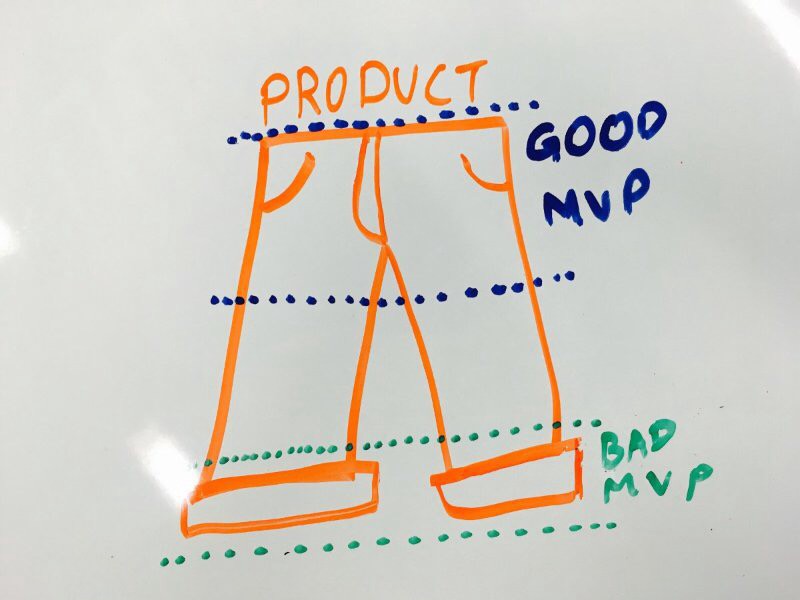When I read Eric Ries' "The Lean Startup" in 2012, I was instantly hooked. It just made so much sense and made you wonder how it hadn't been put into writing before, or more importantly, why more teams weren't applying it?
At the time, the team I was working with was obsessed with building iPhone apps. The closest thing we were doing to testing before building, was useability testing at the very, very end of the process. The gun was already cocked and ready to go. There was no turning back from those designs or selection of features.
Years later, I saw how the MVP concept took off. It was a project manager's dream come true. When budgets got cut or go-live dates were agreed upon, the MVP came in to save the day with its limited scope and clunky experience. Lots of products never improved the MVP, instead, the backlog got saved somewhere in the Jira metaverse, and manual processes came in to help operationalise the scrappy MVP. The customer experience was terrible and conversion sucked. Lots of people got burned by this approach and are now narky at the idea of a half-baked, unscalable product that never delivered what it promised.
Looking back, we now know we had unrealistic and incorrect expectations from the humble MVP.
Just last week, I came across a blog post from David Bland where he shares lessons learned from his 10 years of Lean Startup and MVP experience. It's brilliant and captures a lot of what I've also experienced over the years in product land.
Here are my favourite takeaways:
"Minimum Viable Products are optimised for learning, not scaling"
-
- MVPs are meant to be about learning, not about getting a scrappy thing out the door quickly. They're not meant to be about scaling or even revenue. Don't try to run before you can crawl. Learn first.
- Don't place unrealistic expectations on your MVP and allow yourself to scale in stages.
"While you decide what’s Minimum, the customer determines if it is Viable".
-
- There are many things that need to work for the product to generate traction. Lots of people rush to get to an MVP and then blame the market when it doesn't generate revenue.
- Did you stop to define the traction metrics and leading indicators of revenue? Are they trending up? Are you even measuring them?
- Have a think about conversion rates through your buyer's journey using "Pirate Metrics" (AARRR): Acquisition, Activation, Referrals, Retention and Revenue.
"The most common pivots are Customer Pivot, Problem Pivot and Solution Pivot."
-
- I don't think we see enough Problem Pivots. Understandably, instead of pivoting away from their idea, many startups blame a lack of traction on external factors (the market, timing, lack of features, etc.) and keep persevering with their idea. They lock in on a solution and spend a lot of effort trying to find a customer for it. That's an uphill battle.
- "A Customer Pivot is when you are passionate about the problem, but during customer discovery, you find it is a different segment that has the problem. You pivot from one customer segment to the other, based on what you’ve learned."
- "A Problem Pivot is when you are passionate about the customer, but the problem you thought they had isn’t their most painful one. You pivot from one problem to the other and stay locked in on that customer segment."
- "A Solution Pivot is when you are dialled into the customer and problem, but your solution isn’t a good fit. The value proposition resonates and yet still no one uses it. You pivot from one solution to another, based on what you’ve learned, in hopes of solving the problem in a sustainable manner."
"Almost no one is using Innovation Accounting correctly. Startups aren’t using it because they don’t take the time or lack the skills to instrument analytics and create a baseline."
-
- Many of the teams I work with are still relying on subjectivity and "gut feel" to make decisions, and are expecting metrics typically used in an established company (revenue, customers, ROI, market share) from an MVP.
- People don't seem to think about the cheapest / fastest way to test a hypothesis. Heck, people don't even think about hypotheses, let alone that they need testing! I would say that experimenting as a whole is still perceived as a dark art outside of the innovation/product diehard community.
The truth can hurt
- Showing evidence of the work you've done to validate your business model will help you avoid overpromising and underdelivering. Savvy investors will love it.
- However, it could make you look less sexy than the startup that hasn't done any of that work and is still convincing naive investors by selling "the dream". Gamblers won't like it.
For more on this, check out David's book - "Testing Business Ideas: A Field Guide for Rapid Experimentation"

Image credit: Tristan Cooke
Main image credit: qvik.com